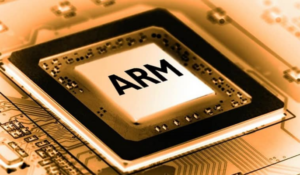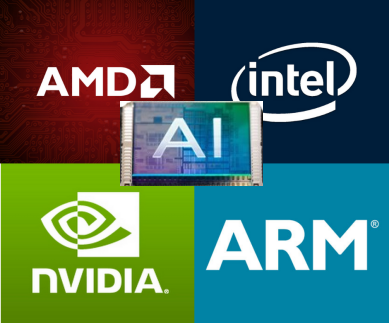In the evolving landscape of semiconductor technology, the battle for dominance among Nvidia, AMD, and Intel has intensified, particularly as Nvidia and AMD make significant strides with ARM-based chips. This competition is reshaping the market, with each company leveraging its strengths to push the boundaries of performance, efficiency, and innovation. This article delves into the dynamics of this battle, highlighting key developments, technological advancements, and the implications for the industry and consumers.
The Semiconductor Titans
Intel: Intel has long been the dominant player in the x86 processor market, supplying CPUs for the majority of personal computers and servers. Known for its high-performance processors, Intel has faced increasing competition as the industry shifts towards more efficient and versatile architectures.
Nvidia: Nvidia is a leader in graphics processing units (GPUs) and has been expanding its influence in AI and data center markets. With its acquisition of ARM Holdings, Nvidia aims to leverage ARM’s efficient architecture to innovate across various segments, including PCs, servers, and AI-driven applications.
AMD: AMD has been a formidable competitor to Intel in the x86 market, offering high-performance CPUs and GPUs. AMD’s focus on delivering value through competitive pricing and performance has helped it gain significant market share in recent years.
ARM Architecture: A New Contender

What is ARM? ARM (Advanced RISC Machine) architecture is known for its power efficiency and reduced instruction set computing (RISC) approach. Unlike x86 architecture, which is complex and power-hungry, ARM processors are designed to be efficient and versatile, making them ideal for mobile devices, embedded systems, and increasingly, laptops and servers.
Advantages of ARM Processor:
ARM processors offer several compelling advantages that have contributed to their widespread adoption across various computing platforms. Firstly, their efficiency in terms of power consumption is a standout feature, particularly important for mobile devices and IoT applications. ARM processors are designed to deliver robust performance while consuming minimal power, which translates to longer battery life and enhanced user experience in smartphones, tablets, and wearable devices. This efficiency also extends to embedded systems and IoT devices, where energy consumption must be carefully managed to ensure reliable operation over extended periods.
Secondly, ARM’s architecture provides scalability and versatility, allowing manufacturers to tailor processors for specific applications and performance requirements. From low-power microcontrollers used in sensors and small devices to high-performance multicore processors powering servers and automotive systems, ARM processors can meet a broad spectrum of computing needs. This scalability not only supports diverse applications but also facilitates cost-effective solutions by optimizing hardware configurations based on performance demands.
Thirdly, ARM processors benefit from a robust ecosystem that includes a wide range of operating systems, development tools, and software libraries. This ecosystem supports rapid innovation and deployment across different industries, from consumer electronics to industrial automation. Developers can leverage well-established tools and libraries to streamline application development and optimize performance on ARM-based platforms, fostering a vibrant ecosystem of applications and services
ARM processors offer several advantages over x86 (including amd64) processors in specific contexts:
- Power Efficiency: ARM processors are known for their energy efficiency compared to x86 processors. This efficiency is crucial for mobile devices, IoT devices, and other battery-powered applications where minimizing power consumption extends battery life and improves device usability. ARM’s architecture is inherently designed to achieve high performance at lower power, making it a preferred choice for portable and embedded systems.
- Scalability: ARM processors provide a high degree of scalability, ranging from simple microcontrollers to complex multicore processors. This scalability allows ARM-based solutions to be tailored to a wide range of applications and performance requirements. In contrast, x86 processors, while powerful, may be overkill for certain low-power or cost-sensitive applications where ARM’s efficiency and flexibility shine.
- Cost-effectiveness: ARM processors often offer a more cost-effective solution, especially for embedded systems and consumer electronics. The licensing model of ARM allows manufacturers to customize and integrate ARM cores into their designs, potentially reducing overall production costs compared to licensing x86 architectures.
- Customizability: ARM’s licensing model enables extensive customization by manufacturers. This flexibility allows companies to create tailored solutions optimized for specific tasks or markets, whether in terms of performance, power consumption, or form factor. This level of customization is less common with x86 architectures, which are typically more standardized and less modular in design.
- Ecosystem and Integration: ARM processors benefit from a robust ecosystem of software and tools developed around the architecture. This includes a wide range of operating systems (such as Android and iOS), development tools, and libraries optimized for ARM-based platforms. This ecosystem support facilitates faster development cycles and easier integration of ARM processors into diverse applications, from mobile devices to industrial automation.
While x86 processors (including amd64 variants) excel in raw processing power and are dominant in desktop and server environments, ARM processors offer significant advantages in power efficiency, scalability, cost-effectiveness, and customization, making them ideal for a broad spectrum of applications ranging from mobile and IoT to embedded systems and specialized computing tasks.
Does Nvidia buy chips from Arm?
Nvidia’s acquisition of ARM Holdings in 2020. The proposed acquisition of Arm Limited by NVIDIA, announced in September 2020, involves NVIDIA purchasing Arm from SoftBank Group (SBG) and the SoftBank Vision Fund for a total transaction value of approximately $40 billion. Here are some key details and aspects of this transaction:
- Strategic Rationale: NVIDIA aims to combine its leading AI computing capabilities with Arm’s vast ecosystem and chip design expertise. This combination could potentially accelerate innovation in AI, edge computing, IoT devices, and other areas where Arm’s energy-efficient designs are prevalent.
- Transaction Structure: The acquisition is structured as a cash-and-stock deal, where NVIDIA will pay a combination of cash and common stock to SoftBank upon completion of the transaction. The exact breakdown of cash versus stock components has not been publicly disclosed in detail.
- Regulatory Approval: The acquisition has faced significant regulatory scrutiny globally due to its potential impact on competition in the semiconductor industry. Regulatory approvals from multiple jurisdictions, including the United States, Europe, China, and other regions, are required before the acquisition can be finalized.
- Completion Timeline: As of early 2022, the acquisition had not been completed. NVIDIA and SoftBank continue to work towards obtaining the necessary regulatory approvals and meeting other closing conditions. The timeline for completion is subject to regulatory processes and approvals in various jurisdictions.
- Industry Implications: If completed, the acquisition could reshape the semiconductor landscape, potentially influencing how technology companies design and distribute semiconductor technology globally. It could also impact the licensing model of Arm’s intellectual property, which is widely used by many semiconductor companies worldwide.
Is AMD working on Arm chips
There hasn’t been any official announcement or information regarding AMD teaming up with Arm to unveil an AI chip family for preprocessing tasks. AMD traditionally focuses on x86 architecture processors, such as those in their Ryzen and EPYC series, and they have not been known to actively develop or promote Arm-based processors. However, the semiconductor industry is dynamic, and partnerships and collaborations can lead to unexpected developments. If such a collaboration were to occur in the future, it could potentially leverage Arm’s expertise in energy-efficient designs and AMD’s strength in AI and processing technologies. For the most accurate and up-to-date information, it would be best to check official announcements from AMD, Arm, or credible industry sources regarding any potential collaborations or developments in this area.
The Versal AI Edge Series Gen 2 processors from Advanced Micro Devices offer a novel heterogeneous processor system that increases performance and optimizes various stages of artificial intelligence. Specifically, by working together on this project, AMD and Arm have created a novel hardware architecture that allows for the optimization of pre-processing, inference, and AI post-processing on a single chip.
But the formal release of AI Edge Series Gen 2 processors is not expected until the end of 2025. We do know, though, that this adaptive SoC will accelerate AI-driven embedded systems from start to finish. The business asserts that these systems are based on enhanced security and safety measures. According to AMD, a variety of markets, including those with strict criteria for security, dependability, lifespan, and security, can use the Versal AI Edge Series Gen 2 chips. Applications include self-driving cars, industrial PCs, self-governing robots, edge AI boxes, and medical ultrasonography, endoscopy, and 3D imaging.
Intel’s Response
Commitment to x86: Intel remains committed to its x86 architecture, continuously innovating to improve performance and efficiency. The introduction of its Alder Lake processors, which combine high-performance and high-efficiency cores, is a direct response to the competitive pressures from ARM and other architectures.
Embracing Hybrid Architecture: Intel is also exploring hybrid architectures that blend the best of x86 and ARM. This approach aims to offer the performance benefits of x86 with the efficiency of ARM, catering to the growing demand for versatile and power-efficient processors.
Investments in AI and Graphics: Intel is investing heavily in AI and graphics technologies to compete with Nvidia and AMD. The development of Intel’s Xe graphics architecture and its AI accelerators aims to provide integrated solutions that can compete with the specialized offerings from its rivals.
Market Implications
Consumer Choice: The competition between Nvidia, AMD, and Intel is beneficial for consumers, as it drives innovation and leads to better products at competitive prices. The introduction of ARM-based laptops and servers provides users with more options, particularly in terms of power efficiency and performance.
Industry Shifts: The growing adoption of ARM architecture is prompting a reevaluation of traditional computing paradigms. Data centers, in particular, are looking at ARM-based solutions for their efficiency and performance advantages, which could lead to significant shifts in the market dynamics.
Software Ecosystem: One of the challenges for ARM adoption is ensuring software compatibility and optimization. Nvidia, AMD, and Intel are all investing in building robust ecosystems to support their respective architectures, which includes working with developers, creating development tools, and ensuring seamless application performance.
The Future of Computing
AI and Machine Learning: AI and machine learning are driving the next wave of computing innovation. Nvidia’s ARM-based chips, with their integrated AI capabilities, are well-positioned to lead in this space. AMD and Intel are also enhancing their AI offerings, aiming to provide powerful and efficient solutions for AI workloads.
Cloud and Edge Computing: The rise of cloud and edge computing is another area where ARM-based chips can excel. Their power efficiency and performance make them ideal for distributed computing environments, where energy consumption and processing power are critical factors.
Sustainability: As the world becomes more conscious of energy consumption and sustainability, ARM’s power-efficient architecture offers significant advantages. Companies adopting ARM-based solutions can reduce their carbon footprint while maintaining high performance, aligning with global sustainability goals.
Conclusion
The battle between Nvidia, AMD, and Intel to dominate the ARM-based chip market is reshaping the future of computing. Each company brings its unique strengths and strategies to the table, driving innovation and offering consumers and businesses new choices in performance and efficiency. As ARM architecture continues to evolve, its impact on the semiconductor industry will be profound, leading to more efficient, powerful, and versatile computing solutions.

